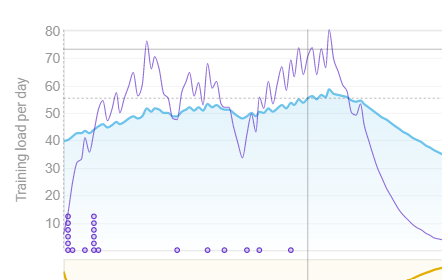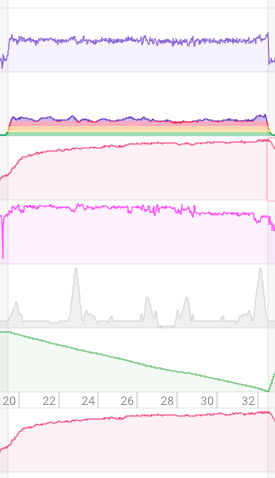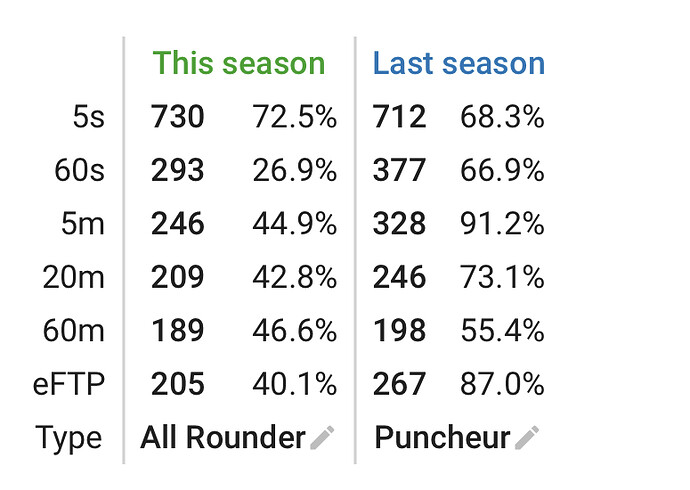Can you please explain the protocol for determining the critical power and the w prime?
any progress with this one David? (auto populating W J)
Hi guys,
I’ve never worried about FTP exactly number once I gauge it based on power intervals durations but I was reading this thread and out of curiosity I went to double check my numbers an em got a doubt.
eFTP at power page shows 205W for this season and at fitness page 252W.
What am I missing here?
I’m very comfortable with 239w manually set.
Thank you,
Hey @david, may I say congratulations and thank you for showing the code? Most developers would never do that. This makes you a very rare and possibly unique developer. Well done!
This is very likely (I am not an expert either) the following:
- eFTP from best effort this season is 205 W
- eFTP from best effort last season was 267 W; if you don’t show comparably hard efforts, this slowly declines with time – for you down to 252 W
If you are happy with the ~240 W for training, that should just be fine, but seeing these numbers I’d assume you could sustain somewhat harder intervals;-)
What‘s there to know?
Assuming you understand FTP (which is in honesty really the hardest part, not only here), these eFTPs are approximations to your FTP, one based on the performance you showed last season, the other one based on performance you showed this season.
The actual approximation, e.g., using Morton‘s 3-point formula, are somewhat explained in the power page and the link to the original literature is provided there, too.
I was trying to do the same thing but found out it’s really hard to make it useful. Problems i have:
-you need to really have your FTP set on point (FTP changes from day to day)
-even if you compute your W’ the real problem is to compute the recovery rate (different for everyone)
-W is calculated from your max effort so using it during intervals can prevent you from reaching really deep
-i think it can be useful during hard rides just as a capacity value to look at when trying to go hard and all out, wahoo doesnt support it so i gave up, but at the same time during such hard effort looking at the Garmin screen seems hard to imagine and at the end if you consider one time all out effort what is the point of knowing when you reach reach your limit, you will reach it anyways 
- negative W means its higher than calculated or your FTP that day is higher than you think, or your rest rate is faster than the app thinks. Should you stop your interval seeing empty W? Maybe. Should you rise your computed W now? Maybe, but what if the next day you gave up on the last interval?
-i think it can be useful as a statistic variable, so after a month of Vo2 intervals you look at it and see if it changes or not like on your graph, but you don’t plan your intervals around your W just know that the planned earlier intervals are working.
But just as you, im interested in W so hope someone will find a nice way to make it more useful.
Forget about last season.
I would like to know about the difference between the eFTP showed for this season (207w) and and the eFTP showed at Fitness chart (252W).
It’s very clear in my first email.
Tks,
The 252 W is the time-declined eFTP from last season, which was 267 W originally, then got lower with time – see your fitness graph.
Right, this is also my understanding, that my current eFTP would be 252W so my doubt is why “This Season eFTP” at “Power menu” shows 205W.
Tks,
Almost there…
The season eFTP is based on efforts performed during this season without historical impact.
The current eFTP is the historical value, declined or not and spanning over the different seasons.
@Lukasz_Pludowski You have it right about W’. It is no more then a guestimate. I can help to give you a starting intensity for anaerobic intervals but you will have to correct when it feels to easy or to hard. In my opinion, VO2max intervals should be done to failure, or almost failure. Always set up a workout with one extra interval and start that last one anyway. This can give you an idea of how much is left when the regular intervals are done.
@MedTechCD has it right.
The eFTP on the /power page is the best value you achieved for the curve selected (42d or this season etc.). The one on /fitness and shown on activities goes up with you do a good enough max effort and gradually decays if you reduce training load.
Some. The big fitness refactoring I am busy with makes this a lot easier to do in future.
Maybe training intensity instead because I’m not reducing my load. On the contrary.
Tks,

Oh, not my experience. Change the weight of your bike by 2 kg or better even change from Road to CX for the same bike/ride – and it will go havoc — huge changes even on that average. And the correct weight is not (necessarily) the one that gives you reasonable est. power.
Frankly very curious of how these 3 apps work in a non-workout mode, as in racing? Have you used it in online races etc?
I dont use Garmin but I found Perf Pro studio (pretty famous among indoor cyclists) can track W’ bal.
I wonder if the meter will work if I connected to Zwift while I had Perf Pro running in the background. Need to try.
Training Power IQ field is now merged with Training HR and called “In The Zone”.
I never race(d). Not IRL and/or virtual.
But I think it is useful because W’ value is automatically adjusted when W’ goes below zero. You do however have to “interpret” the reason why it went below 0. Can be a FTP increase and/or W’ increase.
It also gives some idea on what is left when doing a hard hilly ride.
A quick question on this topic:
After the off-season I lowered my FTP setting by less 20%-ish to slow ramp up and work on the base/endurance zones. After a few weeks I had an indoor 20 min FTP test activity (link) in which my W’ Bal started depleting until it went negative by a large.

My W’ Bal value was still the same from the last season so I wouldn’t expect it to drop like that.
GC gives me 8k as W’ Bal whereas Intervals 20k. So I am bit lost as to which value to use from now on.
My assumption is:
- If I am doing work around my FTP threshold, my W’ Bal shouldn’t drop (or drop that fast). Is this assumption correct?
A small plug on the topic:
I would love to translate work (kJ) into needed Calories intake for races or long outdoor rides so I can adjust carb intake accordingly. I found no secret formula to do that. I would love to have a ball park of how much carbs I should have in a lap based on the amount of work I’ve performed, but I don’t know if that is possible feasible.
If anyone has some tips on this, please share. (I know it is easy to aim for 60-80g carbs/hour blindly)

